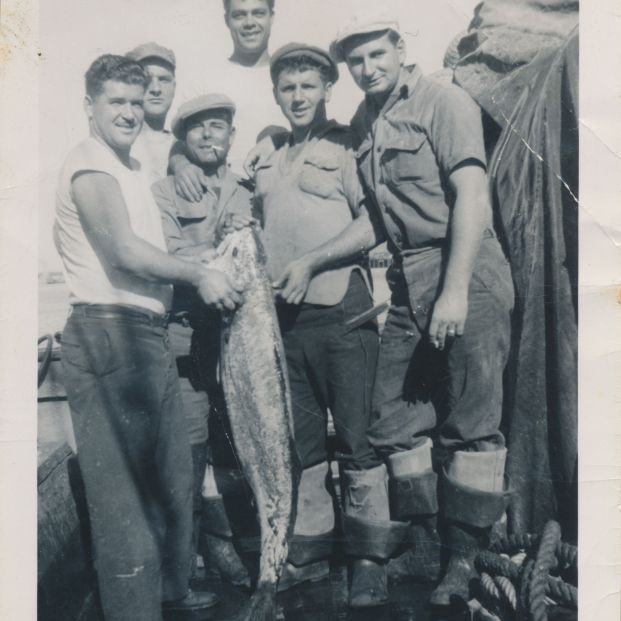3















| Thumbs Up |
| Received: 953 Given: 61 |

Four million Spaniards emigrated to the United States between 1868 and 1945, all were workers, created businesses and founded companies. No ghettos, no mafias, no criminals, no usurers, no parasites. Were fully integrated into society. Currently their descendants don't even speak Spanish. This is why people think that there were no Spanish immigrants in the United States, such was the assimilation and unnoticed that they are called "invisible immigrants"
ç

























| Thumbs Up |
| Received: 6,904 Given: 4,896 |

Ramón Estevez

















| Thumbs Up |
| Received: 19,496 Given: 36,934 |

Rita Hayworth














| Thumbs Up |
| Received: 7,537 Given: 4,801 |

Antonio Moreno
Some of the Spanish actors who made the Spanish versions of American films were captured for the original English versions.

https://www.yfull.com/tree/E-BY7449/
E-V22 - E-BY7449 - E-BY7566 - E-FT155550
According to oral family tradition E-FT155550 comes from a deserter of Napoleon's troops (1808-1813) who stayed in Spain and changed his surname.














| Thumbs Up |
| Received: 111 Given: 5 |

4 million that is way off the mark, between 1820 and 2010 the number does not even reach 400,000. Even to Argentina the number between 1857 and 1960 is 2.2 million. Below is a link with the immigration data from different countries by period, with 322,990 Spaniards entering the country between 1820 and 2010. The number of people with some sort of Spanish ancestry is much higher in the U.S. due to mostly Latin American immigration.
http://teacher.scholastic.com/activi...gion_table.pdf













| Thumbs Up |
| Received: 953 Given: 61 |

I suppose it is a mistake, and they are 4 million to the total of America
google translation:
The barely known history of Spanish immigration to the United States between the end of the 19th century and the beginning of the 20th, a process in which almost four million people arrived in the country, was presented today in the Library of Congress on the occasion of the book "Invisible Immigrants" .
"It is overwhelming to present this project in a place like the Library of Congress," explained James Fernández, professor of history at New York University and co-author of the book with Spanish filmmaker Luis Argeo.
Fernández, of Asturian origin, stressed that between 1850 and 1915 "four million Spaniards" arrived in the United States.
Therefore, he stressed that "the Spanish presence in the country is a modern phenomenon" against the image of the "conquerors" who arrived in the territory of what is now the US centuries ago, and whose numbers were in the hundreds of thousands.
"These immigrants did it in a quieter way, they came to work," he said.
"Invisible Immigrants: Spanish in the USA 1868-1945", documents the key facts of Spanish immigration to the country with the arrival of the 20th century, such as the arrival of 8,000 Andalusians to Hawaii between 1907 and 1913 to work in the sugar cane fields of these Pacific islands.
"What was sought was to contribute white workers to an archipelago recently annexed to the United States," Fernández said before an audience made up partially of descendants of those Spanish immigrants.
Much of them later moved to California in search of better living conditions, while many immigrants from the Basque Country settled as herders and ranchers in the northwest of the country, in the current states of Idaho or Montana.
Another of the fundamental enclaves of Spanish immigration is Tampa, in Florida, where numerous tobacco factories were installed until it became the world capital of cigars at the end of the 19th century; or New York, in which Galicians or Valencians founded businesses and stores until constituting in the 1920s a neighborhood in southern Manhattan known as Little Spain (Little Spain).
Likewise, the American metallurgical sector, especially that related to zinc, was fed by flows of workers from the mines of Asturias and Andalusia, who settled in West Virginia, Missouri or Ohio.
Descendants of them are figures such as actor Martin Sheen (whose first name is Ramón Antonio Gerardo Estévez), rock musician Jerry Garcia or baseball star Lou Piniella, Fernández recalled.
At the same time, he did not miss the opportunity to point out that food brands such as Goya and Bustelo coffee, popular today in the country, were also founded by members of this immigrant community.
The book is based on photographic archives compiled by Fernández and Argeo from family albums and personal collections in which these young families are shown maintaining traditions in unknown territory, and surviving events essential to the history of Spain such as the Civil War ( 1936-39).
"The Civil War was a defining moment. It was then that many realized that going back was not going to be easy, and in some cases there would be no going back," said Fernández.
The event was organized by the Hispanic Department of the Library of Congress and the Hispanic Cultural Society within the framework of Hispanic Heritage Month.
Also participating in the presentation was Enrique Sardá, Consul General of Spain in Washington, who "was deeply moved by the collected stories that portray a fascinating human experience."
https://www.efe.com/efe/america/ame-...000034-2716386


















| Thumbs Up |
| Received: 21,067 Given: 39,632 |

That doesn't even include all the colonial Iberians that immigrated to the Carolinas and throughout the south.
Those who want to live, let them fight, and those who do not want to fight in this world of eternal struggle do not deserve to live.
Even if this were hard--that is how it is ! Assuredly, however, by far the harder fate is that which strikes the man who thinks he can overcome Nature, but in the last analysis only mocks her. Distress, misfortune, and diseases are her answer.
Kekgenes K13
1 Swahili+ Jew + Kekistani + Trailerparkistan @ 6.9420
M.T.A
Celt + Frank (4.869)
Viking Icelandic + Frank (5.463)
Viking Icelandic + Celt (5.545)
Celt + Saxon (5.789)
Viking Danish + Celt (6.283)
Celt (6.539)
Frank (10.13)
Viking Icelandic (10.34)
Viking Danish (10.4)
Saxon (10.79)
kit 2
Celt + Belgae (4.016)
Viking Danish + Belgae (5.555)
Belgae + Frank (5.797)
Celt + Frank (6.031)
Celt (6.297)
Viking Danish + Celt (6.441)
Belgae (8.662)
Viking Danish (8.925)
Frank (9.409)
Saxon (10.83)














| Thumbs Up |
| Received: 111 Given: 5 |

I think the main reason that Spaniards are overlooked is of course the small numbers that came to the U.S. not only compared with British, Germans, Irish and Italians, but even when compared with Greeks or Portuguese. Spaniards did not seem to be too attracted to the U.S. especially compared with the opportunities offered to them in Latin America, France or French Algeria.
Spanish-Born by Country in 1920-1921
Argentina 829,701
France 254,980
Cuba 245,644
Brazil 219,142
Algeria 144,328
Uruguay 54,885
USA 49,535
Mexico 26,675
Chile 25,962
Another reason that Spaniards were considered invisible is because they always outnumbered by migrants from either Mexico, Cuba or Puerto Rico who spoke the same language. For better or for worse some of these people call themselves "Spanish" when it often has nothing to do with Spain, so in many Americans' minds Spanish is associated with Latin America. I notice that Puerto Ricans and Dominicans especially tend to refer to Spanish-speakers as "Spanish".
According to the census records, the number of Spanish-born in the U.S. reached its peak in 2010 with 83,242. I looked at the 1920 census, and Spaniards were overwhelmingly concentrated in California where nearly half lived, and in New York with nearly one-third of all Spanish-born individuals living in New York City. These were areas with much larger European groups so they were likely overshadowed. Around 10% were Spanish Basques living in Idaho and Nevada, but they usually just identify as Basque so even the idea that they are Spanish is lost on many people.
The number of Spanish arriving in the U.S. was slightly smaller than the Danes, and overall I would say that their immigrant communities were outside of some pockets not very visible either. Between 1820 and 2010 532,000 Portuguese that migrated to the U.S. which is 60% higher than the number of Spaniards. However, of these around 70% were from the Azores. Despite this, outside of Southern New England, California's Central Valley and Hawaii where they settled most Americans have little clue about Portugal or Portuguese people.
I would say that Spain's cultural impact on the U.S. cannot be denied however. So many place names in the Southwest and in California in particular bear testament to the Spanish presence. In addition, Christopher Columbus, Ponce de León, Hernando de Soto and Álvar Núńez Cabeza de Vaca were names I learned about in history class and were until recently celebrated as having been important to the founding of the United States. Also, the number of people with at least some Spanish ancestry who have come from Latin America is now in the many millions.















| Thumbs Up |
| Received: 2,022 Given: 2,705 |

Jared Leto is part Spanish.
















| Thumbs Up |
| Received: 17,901 Given: 18,310 |

Lou Piniella has pure Spanish heritage (Asturian). From Tampa, Florida. One of the few pure Spanish Americans I can think of. https://en.wikipedia.org/wiki/Lou_Piniella

There are currently 1 users browsing this thread. (0 members and 1 guests)
 Latin America
Latin America
 România
România
 Norge
Norge
Bookmarks